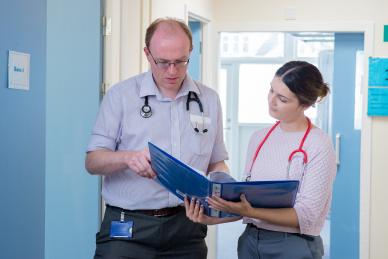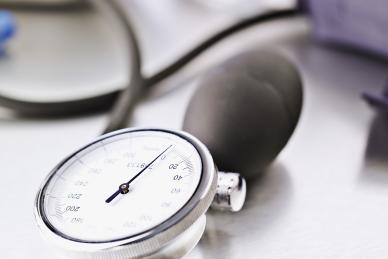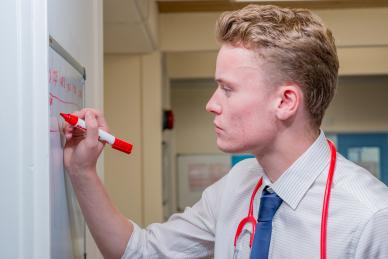Events
We host events on Haematology and other related fields throughout the year. Visit our events programme to find out more.
Empowering medical excellence, shaping healthcare futures.
Continuity of care
Varied caseload in terms of chronicity of diseases and ages of patients
Fascinating subject
Retain generic general medical skills as once under haematology care (especially in haemato-oncology) - patients are encouraged to bypass GPs/A&E and report directly to the Haematology Unit
Working at the forefront of medical developments with therapies often offered in the context of clinical trials
Scope for sub-specialising – for example: haemato-oncology, transfusion medicine, coagulation
24-hour non-resident on-calls
Multi-disciplinary working – especially with laboratory staff and managers
Some cases can be emotionally difficult to deal with and difficult to detach from – especially when concerning patients well-known to the haematology team
Difficult and expensive postgraduate exams
Expensive chemotherapy drugs are becoming more difficult to access which generates vast amounts of paperwork in some cases which need Chairman’s Actions, Primary Care Trust (PCT) approval etc
Dr Joanna Haughton - ST5.
"I genuinely find haematology to be a fascinating and very logical subject (although ask me on a Friday night on-call when puzzling over a sick transplant patient and I may not think this then!)"

Haematology provides such a broad spectrum of diseases presenting in a wide ranging manner of ways in such a varied cohort of patients – from the teenager with severe haemophilia A and a head injury necessitating urgent factor replacement, to the octogenarian with asymptomatic myeloma simply requiring reassurance and the 40-year-old with multiply relapsed lymphoma needing palliative care. I can truly say that no one day is the same as the next.
Haematologists are renowned for not letting others take care of their patients and following them up for years beyond what is strictly necessary, however this approach promotes continuity, trust and makes for great patient/doctor relationships which can sometimes be overlooked in this culture of fast-paced sub-specialised medicine.
I genuinely find haematology to be a fascinating and very logical subject (although ask me on a Friday night on-call when puzzling over a sick transplant patient and I may not think this then!). Correlating exactly what is on the blood film or bone marrow smears with signs and symptoms facilitates understanding of the disorders and is immensely satisfying. Even getting back to basics with the coagulation cascade can just help sort out why someone might have an isolated activated prolonged thromboplastin time (APTT) and make the difference between someone getting an urgent operation or not.
Haematologists – especially at ST level – are heavily involved in day-to-day patient care which can be overwhelming at times but also helps to keep grounded and maintain clinical skills and at least some (basic!) general medical knowledge.
The 24-hour on-calls appealed to me as the night shifts on Medical Assessment Units (MAUs) began to take their toll in the latter months of my ST2 training and although I missed the MAU environment initially, on-call phone calls from exhausted Medical SpRs trying to fire fight referrals from all corners of the hospital at 2:00 am remind me that – even though I have a broken night’s sleep every week or so – things could be much worse!
Demonstrate that you have a holistic approach with an appreciation of the multi-disciplinary team (MDT) would, I’m sure, be welcomed on an application form for haematology
Audits, projects or case reports which show an interest in the subject would no doubt help
Showing knowledge of and enthusiasm for, the less ‘glamorous’ side of haematology (such as anticoagulant services and laboratory management) will also be favoured
Gaining experience in performing bone marrow biopsies, lumbar punctures and Hickman line removals will display motivation and will give you a head start once in the post
A typical day of a Haematology SpR usually begins with a ward round. The inpatients beds are usually used by people receiving intensive chemotherapy for diseases such as acute myeloid leukaemia and high-grade lymphoma. Inpatients are also often those with complications of chemotherapy – such as neutropenic sepsis and tumour lysis syndrome – and may include the odd sickle cell crisis or autoimmune haemolytic anaemia.
When on-call, mid-morning is punctuated by calls from GPs asking for advice on a whole manner of issues – from painless, persistent lymphadenopathy to elevated platelets. The day unit often requires attention at this time – either to review patients who have attended for blood transfusions or to address uncontrolled chemotherapy side-effects. Lunchtime multi-disciplinary meetings provide time to discuss new referrals or existing patients with new problems in conjunction with radiologists and haemato-histopathologists. Afternoons may consist of reviewing new ward referrals, speaking to families, administering intra-thecal chemotherapy, performing bone marrow biopsies, visiting the lab and reviewing the previous days’ blood films or a combination of the above!
Clinics will, no doubt, form a large part of any haematologist’s timetable. General haematology clinics consist of follow-up patients with sickling disorders, thalassaemia, anaemia and ITP; here chronic disease management comes into play. Such clinics facilitate review of new referrals with often isolated abnormal blood parameters, checked as part of routine primary care assessments – for example: raised ferritin, elevated platelets and eosinophilia. Cases such as these can be fascinating and lead to a wide range of conclusions – not always primary haematological disorders. The malignant haematology clinics enable outpatient management of most of the patients with low-grade lymphomas, myeloma and chronic lymphocytic leukaemia. They also provide a setting for long-term follow-up of patients with previously treated haematological malignancies such as AML and high-grade lymphomas. As well as looking for signs of relapse, these enable early detection of any long-term effects of chemotherapy. These are incredibly satisfying and reinforce the continuity and close relationships that are often established during arduous weeks of inpatient chemotherapy.
If on-call, typically the SpR can make their journey home at 7:00 pm – 8:00 pm then await calls from surgeons needing international normalised ratios (INRs) reversing, obstetricians requiring blood product support for major obstetric haemorrhages, medics asking for help investigating thrombocytopenia and, rarely, the haematology biomedical scientist concerned about blood film appearances showing acute myeloid leukaemia (AML). Note that on-calls are usually 24-hour non-resident and depending on how busy the hospital is, one can usually guarantee a decent amount of sleep despite it being interrupted for advice. Plus waking up every couple of hours to conduct a five-minute phone call cannot be begrudged – especially when the doctor desperate for the advice can barely be heard over the chaos of Accident and Emergency (A&E) or the Medical Assessment Unit.






A varied and stimulating discipline which involves laboratory investigation and clinical management of patients with disorders of the blood.
Training lasts for five years and begins at ST3 level following two years or more of training in general medicine. A trainee will gain experience in haemato-oncology, haematopoetic transplant, transfusion, coagulation, laboratory haematology, paediatric haematology and general haematology. The broad range of diseases which come under ‘general haematology’ include the haemoglobinopathies, haemolytic anaemias, nutritional anaemias and idiopathic thrombocytopenic purpura, to name a few.
To gain entry into haematology, one must possess either Membership of the Royal College of Physicians (MRCP) or Royal College of Paediatrics and Child Health (MRCPCH). On completion of training, membership of the Royal College of Pathologists (MRCPath) needs to be achieved. The MRCPath exams begin no sooner than 18 months into haematology training with the part I exam - an essay paper followed by multiple choice questions (MCQ) (held on the same day). The second and more arduous task is completing the Part II exam which is usually delayed until the latter years of training. This exam consists of a morphology exam on day one, written papers on coagulation and transfusion medicine on day two and four 15-minute vivas on haemato-oncology, general haematology, coagulation and transfusion medicine at the end of day three. The exams are an inevitable part of haematology training and although seem daunting at the outset, can be adequately spaced to allow for some breathing space and enjoyment of the specialty in between.
Bone marrow biopsies and lumbar punctures – to enable administration of intra-thecal chemotherapy – are performed on a more-or-less a weekly basis. Hickman line removal is also primarily undertaken by the haematology STs in some hospitals. It is helpful if a trainee has at least seen these being done prior to haematology training but there are plenty of opportunities at the beginning of training to develop such skills.
Mandatory training courses may include the National Blood Service basic and intermediate transfusion courses, a coagulation course and a management course for Registrars in pathology. Haematology morphology, histopathology of the bone marrow and haemoglobinopathy courses are also considered essential. Trainees are expected to attend the British Society of Haematology Annual Society Meeting twice during their training but are also encouraged to attend European Haematology and American Society of Haematology annual meetings additionally. These provide great opportunities to appreciate how different aspects of haematology are practiced around the world and learn of new developments in the rapidly evolving area of medicine. They are also great opportunities to meet other haematologists (contrary to popular belief, haematologists do know how to have fun!).
The Eportfolio is a tool by which the trainee is assessed at the annual review of competence progression (ARCP) and ideally should be used to record attendance at organised regional teaching, clinical assessments audits and presentations.
Blood film interpretation can cause trainees concern in the early stages of training however the purple and red dots floating down the microscope soon start to make sense and become an invaluable piece of information in the assessment of a patient. The satisfaction of reviewing a patient with puzzling symptoms, correlating these with their blood parameters then deducing a diagnosis after studying their blood film cannot be underestimated.
Haematology is traditionally viewed as an academic specialty therefore research is encouraged and opportunities are provided for out of programme research (OOPR) experiences. If the trainee is hoping to obtain a Consultant post in a teaching hospital, he/she will almost always be expected to hold a postgraduate degree.

We host events on Haematology and other related fields throughout the year. Visit our events programme to find out more.